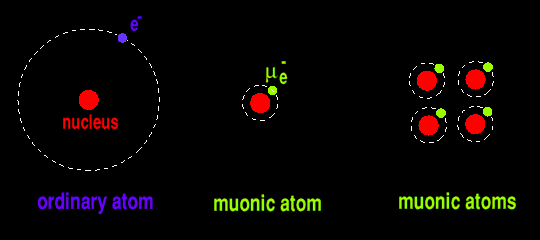
MUONIC CATALYSED FUSION
COLD FUSION WITHIN MUONIC MATTER
Cold fusion has, however, been observed in muonic matter. Muons, the 200-fold heavier second generation member of the electron family, have the same charge as the electron. When muons replace the electrons in atoms, the resulting muonic clouds surrounding the normal sized nucleus are 200 times smaller than the electron cloud around normal atoms. The force stopping two deuterium nuclei from approaching close enough for fusion is their electrical (coulombic) repulsion between like positive harges (from their protons). Negatively charged electrons normally shield such repulsive forces, neutralising them, but with the muon shield being 200 times closer to the nucleus, the atoms can relax at a distance 200 times closer together (but this is still 100 times further apart than nucleons within nuclei)). Neighbouring nuclei in muonic molecules are thus 200 times closer; close enough to undergo nuclear fusion (by tunnelling) even at a temperature as cold as 10 Kelvin.
Fusion of muonic deuterium with muonic tritium in the muonic molecule equivalent to DT (a molecule of one sort of heavy hydrogen) has been observed to occur at 1 million fusions per second. The muons can be produced by smashing protons accelerated to 800MeV into a graphite target, to produce pions, which subsequently decay into muons. But because a considerable energy is expended in producing the muons, this reaction is a net consumer of energy rather than a net releaser. After the fusion reaction, if the muon has not decayed, it is free to create another muonic molecule. Unfortunately, if it forms muonic helium with the product of fusion, an alpha particle, it is wasted. If one muon can be persuaded to so catalyse the fusion of 300 DT molecules, break-even might be achieved. This catalytic feat has to be performed within the lifetime of the muon, which is 2.2 microseconds. So far, muons have been observed to catalyse the fusion between 200 molecules of DT before decaying back into an electron.



![]()